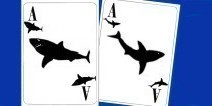|

Join our Newsletter
& get our free guide Starting Hands Revealed
We hate spam too!
We value your privacy and never share your email. All our emails have an opt-out link. Click it, and you will never hear from us again. 
|
BluffingBluffing is the tactic most often associated with poker in the public's mind, and for good reasons. Bluffs exploit the "imperfect information" concept inherent in poker. No great poker pro can succeed in the game without some bluffing. Conversely hold'em poker stars cannot succeed without trying to catch out some bluffs as well. 
Without bluffing, chance would even out over time and good players would tend to tie up in the long run as the strength of their hands would become the only determining factor. Furthermore, as the frequency of being dealt a monster is quite low, you have to take your chance and bluff once in a while in order to compensate for the general paucity of hands dealt to you. Bluffing can make you win the hand that you are playing now if your opponent folds, but even if you get caught and lose the hand, it has the benefit of giving you the image of a bluffer, so that opponents will call your big bets more easily the next time you have a big hand. Bluffing in No-Limit Texas Hold'emBluffing is most effective in no-limit games where your opponent may have to invest his entire stack in order to catch your bluff, whereas in limit games it only costs a few big blinds as he just needs to call all the way (assuming no raising battle). There are various kinds of bluffs; semi-bluffs, bluffs with air, bluffs with a "scary card", bluffs against weakness, etc. Conversely bluffs can be induced within a trap by playing very weakly a very strong hand, hoping to get raised so that you can 3-bet the bluffer. Good bluffs are difficult to execute as they go against our human nature. We naturally tend to bet more when we have a strong hand, and to risk a little less when we have nothing. This is an exploitable betting pattern, so one of the keys to successful bluffing is to display as much consistency as possible, and betting our strong hands the same way that we bet our weak bluffing hands. This is one of the traits of poker masters such as Phil Ivey who is known to be able to play any hand as if he had rockets. Bluffing is a matter of seizing the right opportunity at the right time, not of throwing random gambles based on our mood. For instance in a raised pot, it is customary to reraise with the nuts flush draw. This is called a semi-bluff because there is the possibility of hitting a big hand at the next street. Position is very important in bluffs, and being last to act in a checked pot provides a good chance to bluff with any two cards. "Stealing" situations are standard bluffing spots taking advantage of position, e.g. button versus small blind. An example of a real bluff which took place in an online no-limit holdem $2/$4 game at PokerStars went as follow. Example of a nice BluffHero is in the cut-off with A♣ J♥. Hero calls one standard raise from a middle position villain (VPIP=13/PFR=7), and small blind (unknown) calls. Flop is K♦T♣2♦, giving a gut shot to hero, which is a very bad hand to draw on as there are only 4 outs. The hand is checked to hero who is last to act. He decides to represent a king assuming that the rock villain would have bet if he had a king. So hero bets $32 into the $44 pot, small blind folds, villains calls. The turn is 8♥ which is a blank. Villain checks and even though hero missed, he has to second barrel bluff, otherwise his plan would fall apart. So he bets $84 into a $107 pot and get called, making the pot $275. This is where it is starting to get scary, as hero has invested a lot of chips and only has ace high so far. The river comes 3♣, which is another blank and villain checks again. It was time to make a significant third barrel bet to continue representing the same strong hand value betting at the river. Hero bet $225 and villain finally gave up and fold. This example shows that both brain and guts are necessary ingredients in conducting a successful bluff. Brain because it must be well timed and executed. It relied on hand reading, betting patterns and player's style analysis. This bluff worked because the villain was a rock, but against a calling station this would have probably not worked. Guts because whoever can pull such bluff needs a lot of them. One of the hardest thing to do in poker is to pull a three barrel bluff with air. This is the mark of a master. Here it was assumed that villain had a medium hand such as QQ or a drawing hand as there were both a straight draw and a flush draw. As two blank cards came out and the draws remained uncompleted, it appeared very unlikely that villain had improved his hand, so he had to give way to the large final bet. One last word of advice. Do not try three barrel bluffing a calling station or a maniac, as this is just asking for disaster. Bluffs are mostly effective against weak tight or TAGfish players who can lay down their good hands. Don't try them against calling stations. Learn to understand your opponents and know when to stop or when to increase the pressure. |









